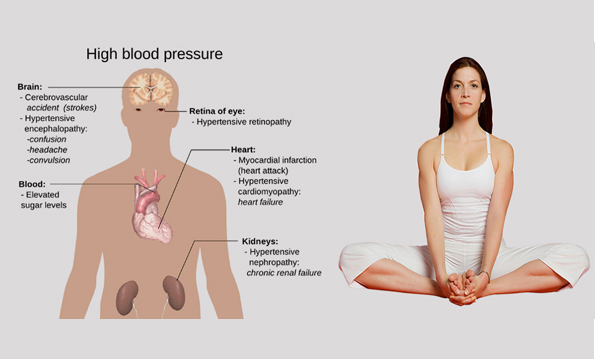A high-stress lifestyle can lead to what doctors call “essential” hypertension, where there is no disease-specific cause.
Although several conditions can cause secondary high blood pressure (kidney disease, hormone abnormalities, type 2 diabetes), more often than not a high-stress lifestyle can lead to what doctors call “essential” hypertension, where there is no disease-specific cause. Yoga, when performed mindfully, can reduce this type of stress-induced hypertension, while addressing its underlying causes. It pacifies the sympathetic nervous system and slows down the heart, while teaching the muscles and mind to relax deeply. Pranayama can also be extremely beneficial. Research studies demonstrate that conscious breathing quickly lowers blood pressure. Practicing pranayama while lying down encourages the breath to arise smoothly from a relaxed state, without any force. If you do choose to sit, keep your spine straight and lift your chest, while keeping your head down in jalandhara bandha, so that there is no strain on the heart.Yoga can reduce stress-induced hypertension, while addressing its underlying causes. It pacifies the sympathetic nervous system and slows down the heart, while teaching the muscles and mind to relax deeply.
While a general yoga practice has a pacifying effect and can bring the nervous system into balance, some asanas work better than others for actually lowering blood pressure—and simple modifications make others more beneficial. For example, do cooling poses, such as forward bends where the head is supported—to bring a sense of calm to the head, neck, face, and diaphragm. Modify any standing poses in which the arms are normally extended overhead (likevirabhadrasana I) by placing your hands on your hips. In trikonasana (triangle pose), look down toward the floor instead of up at the ceiling to keep blood pressure from rising. Steer clear of poses that compress the front of the diaphragm, such as dhanurasana (bow pose) and mayurasana (peacock pose), which can drive blood pressure up. Anyone with untreated high blood pressure should avoid unsupported inversions, such as shirshasana (headstand pose) or adho mukha vrikshasana (handstand pose)—or any other pose in which they can feel pressure in the throat or temples, or that cause respiration to become heavy or difficult. Practicing a modified halasana (plow pose) is a good way to experience the benefits of inversions without the potentially harmful effects, because you can learn to bear weight on the upper body and lengthen the sides of the neck without any strain. So if your blood pressure reads on the high side, stick to the modified version below.
Forward bends and other introverted asanas teach us how to quiet the brain and lengthen and soften the neck along the path of the carotid artery. When doing these poses to lower blood pressure, support the head, which has a cooling, calming effect on the whole body.
Practicing a modified halasana (plow pose) is a good way to experience the benefits of inversions without the potentially harmful effects, because you can learn to bear weight on the upper body and lengthen the sides of the neck without any strain. So if your blood pressure reads on the high side, stick to the modified version below.
Forward bends and other introverted asanas teach us how to quiet the brain and lengthen and soften the neck along the path of the carotid artery. When doing these poses to lower blood pressure, support the head, which has a cooling, calming effect on the whole body. Disclaimer
Yoga Ayurveda Therapy is Complementary Medicine and doesn't alternates any conventional treatment.
Yoga-Ayurveda Therapy needs physical assistance which may need physical touch. You can ask teacher or therapist not to give physical touch or assistance and based on whatever you choose, our teacher or therapist will follow the instructions. Any point you want to change the preference, then please inform teacher or therapist and management in writing. You will take responsibility of your decision and will not hold Union Yoga Ayurveda responsible for any kind of damage.
All kind of Yoga Ayurveda teaching and therapy can cause certain injuries and you are accepting those injuries. Signing up for the therapy or yoga courses means that you are aware of the probable injuries.
Union Yoga Ayurveda (Union Centre Pte Ltd) and its staff are not liable or responsible for any injuries caused during the session which are visible or not visible, physical or hormonal or mental. You as client take full responsibility of your own decision and will not claim any kind of compensation in terms of money or any resources for the damage caused because of due process.
Prev Post
TREMORS ISSUES
Next Post

